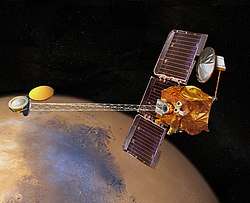Tianwen-1
Tianwen-1 (known as Huoxing-1, HX-1 during development[10]) is a planned mission by China to send a spacecraft, which consists of an orbiter, a lander and a rover, to Mars.[11] The name "Tianwen" (Chinese: 天問), which means Heavenly Questions or Questions to Heaven, comes from the long poem of the same name written by Qu Yuan (about 340–278 BC), one of the greatest poets of ancient China.[12] The mission is planned to be launched on 23 July 2020[13][14] with a Long March 5 heavy lift rocket.[15][16][17] Its stated objectives are to search for evidence of both current and past life, and to assess the planet's environment.[4][18]
.png) Tianwen-1 undergoing tests in 2019 | |
| Names | Huoxing-1 (2018–20)[1][2][3] |
|---|---|
| Mission type | Planetary science with an orbiter, lander and rover |
| Operator | CNSA |
| Mission duration | Orbiter: ≥ 1 Earth year Rover: 90 sols[4] |
| Spacecraft properties | |
| Spacecraft type | Orbiter, lander, rover |
| Launch mass | Total: 5,000 kg (11,000 lb) Orbiter: 3,175 kg (7,000 lb) Rover:240 kg (530 lb) |
| Dimensions | Rover: 2.0 × 1.65 × 0.8 metre |
| Start of mission | |
| Launch date | 23 July 2020[5][6][7] |
| Rocket | Long March 5 |
| Launch site | Wenchang Spacecraft Launch Site, LC101 |
| Contractor | China Aerospace Science and Technology Corporation |
| Mars orbiter | |
| Spacecraft component | Orbiter |
| Orbital insertion | 11 to 24 February 2021[7] |
| Mars lander | |
| Spacecraft component | Lander[8] |
| Landing date | 23 April 2021[7] (proposed) |
| Landing site | Utopia Planitia (2 preliminary sites)[9] |
| Mars rover | |
| Spacecraft component | Rover |
| Landing date | After 23 April 2021[7] (proposed) |
| Landing site | Utopia Planitia (2 preliminary sites)[9] |
Overview
China's Mars program started in partnership with Russia. In November 2011, the Russian spacecraft Fobos-Grunt, destined for Mars and Phobos, was launched from Baikonur Cosmodrome; the Russian spacecraft carried with it an attached secondary spacecraft: Yinghuo-1, which was intended to become China's first Mars orbiter, (Fobos-Grunt also carried experiments from the Planetary Society and from Bulgaria). However, Fobos-Grunt's main propulsion unit failed to boost the Mars-bound stack from its initial Earth parking orbit and the combined multinational spacecrafts and experiments eventually reentered Earth's atmosphere in January 2012[19]. China subsequently began an independent Mars project[20] and the current mission, which was formally approved by Chinese authorities in early 2016[9], is the result.
The new Chinese Mars spacecraft, consisting of an orbiter and a lander (with an attached rover) is developed by the China Aerospace Science and Technology Corporation (CASC), and managed by the National Space Science Centre (NSSC) in Beijing.[15] The lander portion of the spacecraft will use a parachute, retrorockets, and an airbag in order to achieve landing on the Martian surface.[21] If the landing is successful, the lander would then release a rover. Said rover will be powered by solar panels and is expected to probe the Martian surface with radar and to perform chemical analyses on the soil; it would also look for biomolecules and biosignatures.[4]
The aims of the mission may include the following: find evidence for current and past life, produce Martian surface maps, characterize Martian soil composition and water ice distribution, examine the Martian atmosphere, and in particular, its ionosphere, among others.[22] Simulated Martian landings have been performed as part of mission preparations by the Beijing Institute of Space Mechanics and Electricity.[11]
The current Mars mission also would serve as a demonstration of technology that will be needed for an anticipated Chinese Mars sample-return mission proposed for the 2030s.[15] There was also a plan that involved using the current mission to cache Martian rock and soil samples for retrieval by the later sample-return mission.[23]
Mission planning
In late 2019, the Xi'an Aerospace Propulsion Institute, a subsidiary of CASC, stated that the performance and control of the future spacecraft's propulsion system has been verified and had passed all requisite pre-flight tests, including tests for hovering, hazard avoidance, deceleration, and landing. The main component of the lander's propulsion system consists of a single engine that provides 7500 newtons of thrust. The spacecraft's supersonic parachute system had also been successfully tested previously.[9]
CNSA initially focused on the Chryse Planitia and on the Elysium Mons regions of Mars in its search for possible landing sites for the lander and its associated rover. However, in September 2019, during a joint meeting in Geneva of the European Planetary Science Congress-Division for Planetary Sciences, Chinese presenters announced that two preliminary sites in the Utopia Planitia region of Mars have instead been chosen for the anticipated landing attempt, with each site having a landing ellipse of approximately 100 by 40 kilometres.[9]
On 23 January 2020, China Youth Daily reported that, according to sources from CASC, the Mars probe will be launched in July 2020 by the Long March 5 Y4 carrier rocket. This was the first time that China has officially announced the month in which the probe will be launched from Earth.[5] The newspaper also reported that the Long March 5 Y4 rocket's hydrogen-oxygen engine has completed a 100-seconds test, which was the last engine test prior to the final assembly of the carrier rocket.

Scientific instruments
The orbiter and rover will carry a total of 12 instruments:[15]
- Orbiter
- Medium Resolution Camera (MRC) with a resolution of 100 m from a 400 km orbit[11]
- High Resolution Camera (HRC) with a resolution of 2 m from a 400 km orbit[11]
- Mars Magnetometer (MM)
- Mars Mineral Spectrometer (MMS), to determine elementary composition
- Orbiter Subsurface Radar (OSR)
- Mars Ion and Neutral Particle Analyzer (MINPA)[7]
- Rover
- Ground-Penetrating Radar (GPR), to image about 100 metres (330 ft) below the Martian surface[18]
- Mars Surface Magnetic Field Detector (MSMFD)
- Mars Meteorological Measurement Instrument (MMMI)
- Mars Surface Compound Detector (MSCD)
- Multi-Spectrum Camera (MSC)
- Navigation and Topography Camera (NTC)[7]
See also
- Astrobiology – Science concerned with life in the universe
- Climate of Mars
- ExoMars rover – An astrobiology program studying Mars
- Exploration of Mars
- Life on Mars – Scientific assessments on the microbial habitability of Mars
- List of missions to Mars – Wikipedia list article
- Mars 2020 – A 2020 astrobiology Mars rover mission by NASA
- Mars Orbiter Mission – Indian Mars orbiter, launched in 2013
- Mars sample return mission
References
- "中国火星探测器露真容 明年发射". 12 October 2019.
- The Global Exploration Roadmap. NASA International Space Exploration Coordination Group. January 2018

- China's Deep Space Exploration Roadmap. 2018.
- "China Exclusive: China's aim to explore Mars". Xinhua News. 21 March 2016. Retrieved 24 March 2016.
- "China to launch Mars probe in July". ChinaDaily.com. 23 January 2020. Retrieved 23 January 2020.
- "China shows first images of Mars rover, aims for 2020 mission". Reuters. Retrieved 24 August 2016.
- 2020中国火星探测计划(根据叶院士报告整理 Published in 2018.
- "It's official: China's first Mars lander debuts". China Global Television Network. 14 November 2019. Retrieved 8 January 2020.
- Jones, Andrew (8 November 2019). "China Says Its Mars Landing Technology Is Ready For 2020". IEEE Spectrum. Retrieved 30 December 2019.
- "中国火星探测器露真容 明年发射". 12 October 2019.
- Jones, Andrew (9 February 2018). "China simulates Mars landing in preparation for 2020 mission". GBTimes. Retrieved 3 March 2018.
- "China's First Mars Exploration Mission Named Tianwen-1". XinhuaNet. 24 April 2020. Retrieved 24 April 2020.
- "Launch Schedule". Spaceflight Now. 18 June 2020. Retrieved 19 June 2020.
- "Interview with Zhang Rongqiao, the man behind China's mission to Mars". Youtube. Retrieved 24 August 2016.
China Central Television
- Jones, Andrew (22 February 2016). "China is racing to make the 2020 launch window to Mars". GBTimes. Retrieved 22 February 2016.
- Berger, Eric (22 February 2016). "China pressing ahead with orbiter and lander mission to Mars". Ars Technica. Retrieved 23 February 2016.
- Lu, Shen (4 November 2016). "China says it plans to land rover on Mars in 2020". CNN News. Retrieved 23 February 2016.
- The subsurface penetrating radar on the rover of China's Mars 2020 mission. B. Zhou, S. X. Shen, Y. C. Ji, etal. 2016 16th International Conference on Ground Penetrating Radar (GPR). 13–16 June 2016.
- Zolotukhin, Alexei (15 January 2012). "Russian Phobos-Grunt Mars probe falls in Pacific Ocean". RIA Novosti. Retrieved 16 January 2012.
Phobos-Grunt fragments have crashed down in the Pacific Ocean
- Nan, Wu (24 June 2014). "Next stop – Mars: China aims to send rover to Red Planet within six years". South China Morning Post. Retrieved 23 February 2016.
- Jones, Andrew (21 March 2016). "China reveals more details of its 2020 Mars mission". GB Times. Retrieved 22 March 2016.
- Zhou; et al. (13–16 June 2016). "The subsurface penetrating radar on the rover of China's Mars 2020 mission". 2016 16th International Conference on Ground Penetrating Radar (GPR). pp. 1–4. doi:10.1109/ICGPR.2016.7572700. ISBN 978-1-5090-5181-6.
- China Plans To Land A Rover On Mars In 2020. Alexandra Lozovschi, Inquisitr. January 17, 2019.
External links


.jpg)
.jpg)


_on_1_May_from_Indonesia.jpg)